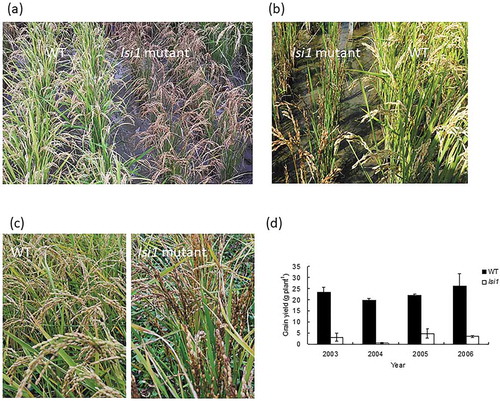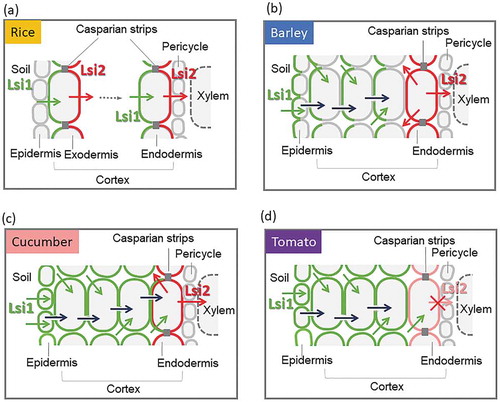Figures & data
Figure 1. Beneficial effects of silicon in rice revealed by lsi1, a mutant defective in Si uptake and accumulation. (a) Overview of wild-type rice (WT) and lsi1 grown in a paddy field. (b) Effect of Si on insect damage. (c) Effect of Si on pathogen infection in the panicles. (d) Effect of Si on grain yield of WT and mutant grown in a paddy field in different years. Data are adapted from Tamai and Ma (Citation2008)

Figure 2. Schematic presentation of Si uptake system in different plant species. (a) Active Si uptake system in rice. Si uptake is cooperatively mediated by Lsi1 and Lsi2, which are polarly localized at the distal and proximal side, respectively, of both exodermis and endodermis. (b) Active Si uptake system in other Si-accumulating species. Si uptake in these species such as barley is also cooperatively mediated by Lsi1 and Lsi2, but localized at different cell layers. HvLsi1 shows polar localization at the distal side, but HvLsi2 does not. (c) Passive uptake system. Si uptake in these plant species such as cucumber, is mediated by CsLsi1 expressed at all cell layers without polarity, and CsLsi2 at the endodermis without polarity. (d) Rejective uptake system. This system is employed by low Si-accumulator such as tomato, which has functional Lsi1, but lacks Lsi2. Arrows with different colors indicate transport processes mediated by different transporters, apoplastic flow, and symplastic flow of Si. See the main text for more details

Figure 3. Schematic presentation of Si distribution in shoot of rice. In leaves, Si in the xylem sap is unloaded by Lsi6, but transporters for further deposition at specific cells are unidentified. In nodes, Si in the xylem of enlarged vascular bundle is first unloaded by Lsi6 localized at the xylem transfer cells, followed by releasing Si toward diffuse vascular bundles by OsLsi2 polarly localized at the bundle sheath cell layer and OsLsi3 localized in the parenchyma tissues between enlarged vascular bundles and diffuse vascular bundles. Arrows with different colors indicate transport processes mediated by different transporters and symplastic flow of Si

Table 1. Characteristics of Si transporters in different plant species and correlation with their Si accumulation. Dark gray indicates that Si transporters have not been identified, while light gray indicates that data on transport activity are not available
